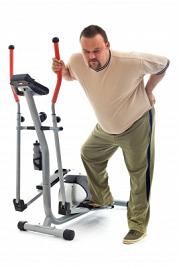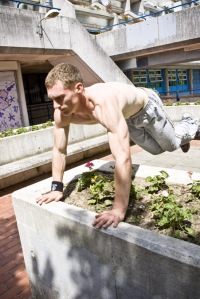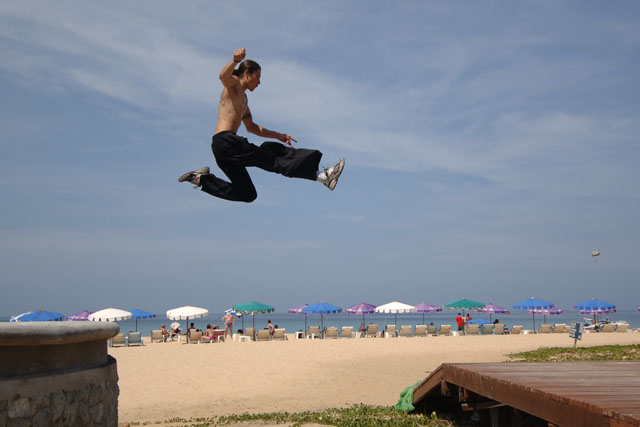You ready for this?
You need to stop exercising. And you need to start moving instead.
What do I mean by that? Well, when we think of exercise we typically imagine high frequency, low variety repetition of consecutive and limited movement patterns. You hit the gym or the sports ground or the running track 3-5 times per week for 30-60 minutes, get very sweaty and out of breath repeating a highly predictable and routine set of movements that may or may not follow the natural function of the human body. Even the ‘functional training’ paradigms that fill the fitness industry now are actually just finding new patterns to slot in the place of the old – kettlebells instead of dumbbells, ring pull ups instead of bar pull ups, – and end up often producing the same results: athletes with specifically strengthened tissues sitting next to underdeveloped tissues, leading to unhealthy loads, deformation and injury.
Our bodies weren’t meant for that. That way of moving – short, intense bursts of limited variety surrounded by hours of inactivity and sedentary living – is a very recent phenomenon in human evolution. Perhaps a few hundred years at most. It’s not the function of the body, it doesn’t nourish us physically or mentally, and the results are clear to see in the general physical debilitation and lack of movement skills of the modern human being. Fitness training is either carried out for aesthetic purposes – to burn fat and build muscular frames – or to supplement specialised sporting practices which have fairly few demands in terms of complexity and adaptability of movement. Look at the current definition of agility as an example – ‘changing direction at speed’ – and tell me that didn’t come about as a result of sports players on a flat pitch needing to dodge and weave past opponents. But if that’s your definition of agility, you’ve never seen how a monkey moves, or a leopard. Or, indeed, a child at play.
Our movement is meant to be so much more: hugely varied, constantly changing and adapting, working with strange alignments and demands, challenging the mind as much as the body… And this leads to health: not to fitness, not to specialised strengths, not to gradual physical breakdown – to health. A very different concept.
Exercise is a part of movement, and that’s all. It’s a useful part, at times, and can be fun, challenging, rewarding and community-building. But that’s all it is: a part. To limit your understanding of movement to whatever your chosen form of ‘exercise’ may be is to limit your potential to that very narrow form of movement.
We get asked all the time how and why parkour athletes are so competent, so skilled, so strong and agile and all-round capable. The answer isn’t in any magic technique or training method. In fact it’s found in the absence of any one training method. It’s because parkour practitioners move fully and properly and holistically, and typically they do it every day and for a good amount of time every day. Their play has become their discipline. They’ve followed their true nature.
Further, they let that movement bleed into every moment of their day – playing with architecture they encounter as they walk, experimenting with new movements while relaxing in the park, even just walking a whole lot more to explore their environment and find good training spots. Parkour is a true movement culture, one of the very very few found in modern industrialised societies.
The key to developing all areas of the body equally and therefore to be holistically healthy is to use your body equally and as a whole: Just running, no – unnatural. Just lifting, unnatural. Just climbing, just crawling, just jumping, just playing squash. By themselves, any one of these will promote unnatural and unhealthy development. But blend all together, combine all these movements and forms of loading the body into holistic movement patterns that require constant adaptation and variation and you’re getting close to how we evolved this amazingly capable physical form in the first place.
But it’s also a mistake to isolate these components of natural movement and think it’ll be effective: combinations of segregated drills practiced consecutively but still in isolation. That’s missing the point entirely – thinking you can strip down our bodies’ need for variable, complex movement patterns into trainable subsets like balancing on a piece of wood on the ground for 30 minutes, or repeated throwing drills by themselves.
 More Than The Sum Of Its Parts
More Than The Sum Of Its Parts
The secret is found in the application of these components as parts of a whole. Movement is more than the sum of its parts. Parkour produces seemingly super-capable humans simply because its entire training paradigm, from day one, is found in movement challenges that are not overly deconstructed or divided into components. The brain, the nervous system, the tissues, all are tested equally and the whole system has to work in unison. In flow.
I find this to be empirical, not theoretical. By far the most overall capable and adaptive group of humans I have encountered is that of the parkour community. They are expert generalists. Not as specialised as other sports and exercises, no – long jumpers jump further, weightlifters can shift more weight, sprinters can cover 100 metres quicker – but parkour practitioners are hugely more capable overall and with a higher baseline of physicality, natural movement and body-mind integration than any other athletic subculture I’ve encountered. There, I said it.
Want proof? Visit YouTube and look at the variety, complexity and sheer scale of movements that parkour practitioners do regularly, and do for fun and with ease. Then bear in mind that the vast majority of these individuals have never followed a programmed, standardised approach to exercise or calculated their one-rep max or done routine gymnastics training – they are the product of consistent, gradually increasing in difficulty, adaptive movement challenges in their natural terrain, be that rural or urban. They can adapt to almost any other training paradigm fairly easily, they are expert at managing risk and fear, and their training brings them deep pleasure and growth across the board. They didn’t start that way, they developed those skills and attributes over time. They aren’t super-human or genetically gifted and they come in all shapes and sizes. They are you plus years of movement training, not exercise.
So, what are the key components to movement health? Here’s my top three:
1. Adaptation
Repetitive training paradigms or environments breed mindlessness, overuse injury, and limited capability. Vary your training routine, your movement patterns and explore your environments as much as possible. Grunting and powering through endless reps of isolated, useless exercises may build your muscles and burn fat but they won’t make you the true mover you’re meant to be. Mix it up, play, explore, when one movement challenge tires you out start working on a different one to let your body recover. There are no ‘leg days’ or ‘arm days’, there are only whole-body days. Let everything get stronger and more mobile in balance with every bring else.
2. Move Holistically
Avoid deconstructing your movement too much. I’ll say it again, movement is more than the sum of its parts. Reduce your patterns to linear, closed chains and guess what – that’s all you’ll ever be able to handle. Shift your thinking towards finding movement challenges that are quirky, technically challenging, and require the body to think in order to solve the problem. Find unique movement challenges by training outdoors on structures that weren’t designed for that purpose and the resulting micro-variations in a regular skill will do you enormous amounts of good.
3. Task-Oriented Training
Your daily movement patterns should include actual challenges, by which I mean they need to be tasks you aren’t sure you’ll conquer first time. They must be difficult enough that you have to bring your whole system to the party in order to overcome them: mind, body and spirit. Don’t be afraid to push yourself in this way; the most gains are made when we are within that thin zone at the edge of our capabilities, where success and failure interact. This means a good blend of technical, physical and cerebral difficulty. This will require your conscious brain to relax a little and allow your unconscious abilities – your natural animalistic, athletic capabilities – to come to the fore to help you succeed. And they will. They lurk in all of us, just below our over-programmed and deconstructed surfaces.
I don’t think mastering our movement is rocket science. It simply requires us to use our bodies the way they can and should be used, which from an evolutionary standpoint means covering terrain and getting over obstacles regularly. The truly amazing thing is that we all have this potential, and over ten years of training and teaching parkour have removed any doubt from my mind that anyone with sufficient desire can achieve these incredible movement skills and abilities. The parkour community continues to go from strength to strength, with teenagers today surpassing the most difficult movements and jumps of only ten years ago with ease. I think that’s because parkour reveals our true holistic potential as human beings. And it will continue to find new heights.
So let’s not try to exercise like machines or even to move like animals – let’s move like humans and take the next step.
For more information on parkour’s concepts and movement methods, see http://www.parkourgenerations.com
Join a class: http://www.parkourgenerations.com/training
Take a course: http://www.parkourgenerations.com/certifications





Really good article and I couldn’t agree more! Especially in the last paragraph where you encourage movement s humans and not machines.
Although if I may give some feedback it would be on the pictures chosen. I think it would be beneficial to see people of all ages move.
Great post otherwise!
LikeLike
Completely agree, Gemellus! My photo library isn’t huge but that’s a very good point. Thanks!
LikeLike
while i agree with the majority of this article, it is still a bit insulting when it is said that most movement forms are useless.. yes, it is true that most modern physical activity has its sacrifices and is indeed specialized such as powerlifting or archery (both disciplines i am practicing).. the human body is indeed an amazing feat of evolutionary engineering and it has the ability to adapt to almost any physical endeavor it is exposed to.. traceurs by nature don’t excel in any one activity as the author pointed out (weightlifters being able to move more weight, sprinters being able to run faster, etc) and that in itself is not wrong.. but some individuals prefer to specialize in a specific discipline or two because that’s what interests them.. i studied parkour a few years ago and the things i was able to do were very fulfilling but it is based on repetition contrary to what the author wrote.. endless jumps, endless rolls, endless climbs and so forth.. the repetitions weren’t chained in a linear pattern such as it is in a training session in archery or gymnastics yes, but it is through repetition that the human body develops that mind/muscle connection to allow “mindlessness”.. being in a “mindlessness” state is not necessarily wrong.. majority of athletes make the things they do easy because of being mindless, being able to perform instinctively and not dwelling too much cognitively on the task at hand.. a well-known example is mushashi miyamoto’s saying of “no mind”, being able to let go of one’s self in order to bring out the best in one’s self.. that’s one of the reasons why he’s considered one of the world’s greatest swordsmen.. so for me at least, to say that all other physical movement including modern sports is wrong is a little insulting because you have to take into account that some people are just not born to be able to move the way others do..
LikeLike
Hi Kenny
And thanks for the comments. Of course, I didn’t say that most movement forms are useless! I practice archery, weightlifting, swordsmanship, unarmed combat, knife throwing, skydiving, etc… the list goes on. All of them serve a purpose and a function. What I’m saying is that the most natural and effective form of training for a human, in terms of general physical development, is that of practical movement over terrain: because that’s how our bodies evolved into what they are today. Repetition is what instills the ability to strengthen kinetic chains, the laying down of myelin in the brain and so on, and so is absolutely vital for mastery of holistic movement skills – but it’s WHAT you repeat that counts. The repetition of bicep curls, I would argue, doesn’t add up to a practical movement skill and therefore isn’t very useful. The repetition of variable movement patterns that overcome obstacles in one’s path, however, is a completely different thing. I’m not arguing that one shouldn’t specialise if one wishes to, absolutely not: I’m glad there are people who are willing to specialise in rugby and destroy their bodies by the time they are 35 – I love watching the international game! But I’m asking whether it’s healthy to do that? And I’m answering that no, overall it is not. High-level performance in almost every specialised sport runs counter to long-term health.
The concept of Mushin or ‘No Mind’ long pre-dates the time of Miyamoto Musashi. And the historicity of Musashi’s life is extremely debatable, anyway 🙂
LikeLiked by 1 person
Very inspiring article. Lots of support!
LikeLike
Thanks!
LikeLike
I love the insight of the article and I agree with it 100%. Even though I became an amateur bodybuilding champion at 19 I still felt that natural movements like those executed while practicing Parkour were congruent with the design of the human body. Nowadays though, I am 51, pretty lean and energetic by I know that unless you’ve been practicing for a good amount of time, trying to do this type of athletic moves at my age could lead to injury. So, what is your view or recipe for those like me 50 and over? Thanks in advance for your answer.
LikeLike
Hi Oscar – no reason you can’t start parkour training at 51. Oldest person in our London classes is 87! Parkour is movement, so as long as you can move then you can improve that movement. Same as any age though, start gradual and progressive, and get good guidance. Come train with us sometime!
LikeLike
What if you’re disabled, and don’t have smooth or well coordinated movements?
LikeLike
Hi Celeste! Great question. The answer is both complex and simple, but in general I believe that as long as we have some movement capacity we can refine and improve it via movement practice. That movement may begin small and simple, but over time any patterns that are built up will become fluid and well coordinated. We do a lot of work with amputee veterans and people with various disabilities and there are some amazing movers among them! Hope that helps.
LikeLike
I like Kuk Sool Won tm, It’s a martial art that is known as the most complete martial art system, and incorporates more ways to move than anything I have encountered. Best Wishes everybody.
LikeLike
Hi Frank,
Has some good movement variety in there, yes – and variability of movement equals health, generally!
LikeLike